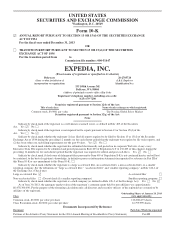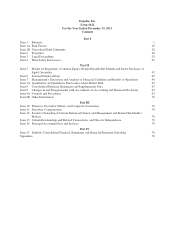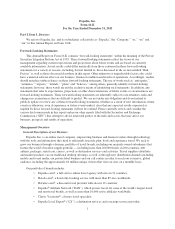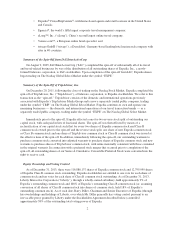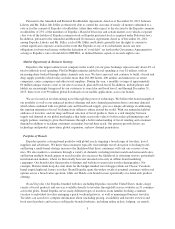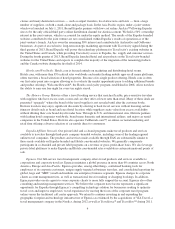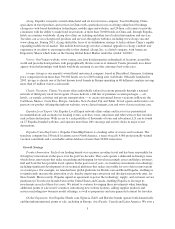Expedia 2013 Annual Report Download - page 13
Download and view the complete annual report
Please find page 13 of the 2013 Expedia annual report below. You can navigate through the pages in the report by either clicking on the pages listed below, or by using the keyword search tool below to find specific information within the annual report.pricing with our suppliers, which often enables us to achieve a higher level of net revenue per transaction as
compared to that provided through the agency model. Today, the majority of our merchant revenue primarily
relates to hotel bookings. As part of the introduction of ETP, we reduced negotiated economics in certain
instances to compensate for hotel supply partners absorbing expenses such as credit card fees and customer
service costs. Therefore, the global rollout of ETP has negatively impacted the margin of revenue we earn per
booking and we expect will continue to do so in the future. In addition, as we continue to expand the breadth and
depth of our global hotel offering and continue to roll out ETP, we have made and expect to continue to make
adjustments to our economics in various geographies including changes based on local market conditions. Based
on these dynamics, we expect our revenue per room night to remain under pressure in the future.
Through our Expedia-branded websites, travelers can dynamically assemble multiple component travel
packages in a single transaction at a lower price as compared to booking each component separately. Packages
assembled by travelers through the packaging model on these websites primarily include a merchant hotel
component and an air or car component. Travelers select packages based on the total package price, without
being provided component pricing. The use of the merchant travel components in packages enables us to make
certain travel products available at prices lower than those charged on an individual component basis by travel
suppliers without impacting their other models. In addition, we also offer third-party pre-assembled package
offerings, primarily through our international points of sale, further broadening our scope of products and
services to travelers. We expect the package product to continue to be marketed primarily using the merchant
model.
Relationships with Travel Partners
Overview. We make travel products and services available from a variety of hotel companies, large and
small commercial airlines, car rental companies, cruise lines and destination service providers. We seek to build
and maintain long-term, strategic relationships with travel suppliers and global distribution system (“GDS”)
partners. An important component of the success of our business depends on our ability to maintain our existing,
as well as build new, relationships with travel suppliers and GDS partners.
Travel Suppliers. We strive to deliver value to our travel supply partners through a wide range of innovative,
targeted merchandising and promotional strategies designed to generate consumer demand and increase their
revenue, while simultaneously reducing their overall marketing transaction and customer service costs. Our
strategic account managers and local hotel market managers work directly with travel suppliers to optimize the
exposure of their travel products and brands through our points of sale, including participation in need-based,
seasonal and event-driven promotions and experimentation within the new channels we are building.
In addition, we have developed proprietary, supplier-oriented technology that streamlines the interaction
between some of our websites and hotel central reservation systems, making it easier and more cost-effective for
hotels to manage reservations made through our brands. Through this “direct connect” technology, hotels can
upload information about available products and services and rates directly from their central reservation systems
into our websites, as well as automatically confirm hotel reservations made by our travelers. In the absence of
direct connect technology, both of these processes are generally completed via a proprietary extranet.
Distribution Partners. GDSs, also referred to as computer reservation services, provide a centralized,
comprehensive repository of travel suppliers’ ‘content’ — such as availability and pricing of seats on various
airline point-to-point flights, or ‘segments.’ The GDSs act as intermediaries between the travel suppliers and
travel agencies, allowing agents to reserve and book flights, rooms or other travel products. Our relationships
with GDSs primarily relate to our air business. We use Sabre, Amadeus and Travelport as our GDS segment
providers in order to ensure the widest possible supply of content for our travelers.
Marketing and Promotions
Our marketing programs are intended to build and maintain the value of our various brands, drive traffic and
ultimately bookings through our various brands and businesses, optimize ongoing traveler acquisition costs and
7


